This article needs additional citations for verification .(November 2019) |

Thomas de Grandison, 4th Baron Grandison (died 1 November 1375), KG, was an English soldier and nobleman.
This article needs additional citations for verification .(November 2019) |

Thomas de Grandison, 4th Baron Grandison (died 1 November 1375), KG, was an English soldier and nobleman.
Thomas was the son of Otes (also seen as Otho) de Grandison (youngest son of William de Grandison, 1st Baron Grandison) and Beatrix Malemayne. He inherited his uncle's John de Grandison titles in 1369.
Grandison led an English force in northwest France in 1370 and was defeated beneath the walls of the Château de la Faigne, by a French army and was captured. [1] He was created a Knight of the Garter in 1370.
Thomas had married Margaret of Caru, with whom he had no issue. He died on 1 November 1375. [2]
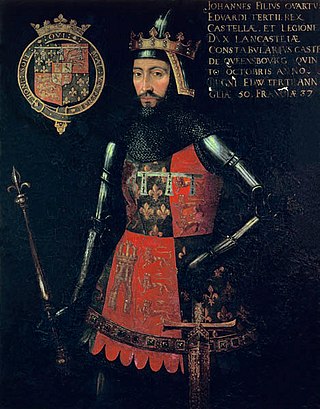
John of Gaunt, Duke of Lancaster was an English royal prince, military leader, and statesman. He was the fourth son of King Edward III of England, and the father of King Henry IV. Because of Gaunt's royal origin, advantageous marriages, and some generous land grants, he was one of the richest men of his era, and was an influential figure during the reigns of both his father and his nephew, Richard II. As Duke of Lancaster, he is the founder of the royal House of Lancaster, whose members would ascend the throne after his death. His birthplace, Ghent in Flanders, then known in English as Gaunt, was the origin of his name.
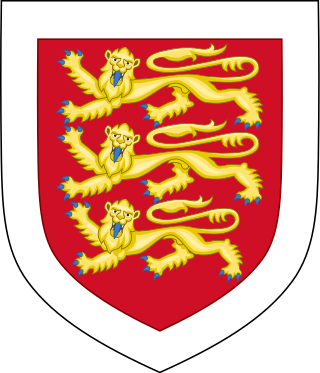
Thomas Holland, 2nd Earl of Kent was an English nobleman and a councillor of his half-brother, King Richard II of England.

John IV the Conqueror KG, was Duke of Brittany and Count of Montfort from 1345 until his death and 7th Earl of Richmond from 1372 until his death.

Constance of Castile was a claimant to the Crown of Castile. She was the daughter of King Peter, who was deposed and killed by his half-brother, King Henry II. She married the English prince John of Gaunt, who fought to obtain the throne of Castile in her name, but ultimately failed.

John Hastings, 2nd Earl of Pembroke, was a fourteenth-century English nobleman and soldier. He also held the titles of Baron Abergavenny and Lord of Wexford. He was born in Sutton Valence, the son of Lord Hastings, and Agnes Mortimer. His father died when John Hastings was around one year old, and he became a ward of King Edward III while remaining in his mother's care. The King arranged for John to marry Edward's daughter Margaret in 1359, which drew John into the royal family. However, Margaret died two years later. John Hastings inherited his father's earldom, subsidiary titles and estates in 1368. The same year, he made a second marriage, to Anne, daughter of Walter, Lord Mauny. The following year, Pembroke began the career in royal service that continued for the rest of his life.

Sir Hugh de Courtenay, 2nd/10th Earl of Devon, 2nd Baron Courtenay, feudal baron of Okehampton and feudal baron of Plympton, played an important role in the Hundred Years War in the service of King Edward III. His chief seats were Tiverton Castle and Okehampton Castle in Devon. The ordinal number given to the early Courtenay Earls of Devon depends on whether the earldom is deemed a new creation by the letters patent granted 22 February 1334/5 or whether it is deemed a restitution of the old dignity of the de Redvers family. Authorities differ in their opinions, and thus alternative ordinal numbers exist, given here.
John (II) de Mowbray, 3rd Baron Mowbray was the only son of John de Mowbray, 2nd Baron Mowbray, by his first wife, Aline de Brewes, daughter of William de Braose, 2nd Baron Braose. He was born in Hovingham, Yorkshire.
George Hastings, 1st Earl of Huntingdon, KB was an English nobleman.

Roger Beauchamp, 1st Baron Beauchamp of Bletsoe was an English soldier and peer who served both King Edward III and his wife, Philippa of Hainault.

William Latimer, 4th Baron Latimer, KG was an English noble, soldier and diplomat. After serving in France and for the household of Edward III, he was impeached during the Good Parliament of 1376, the earliest recorded impeachment in the Parliament of England.
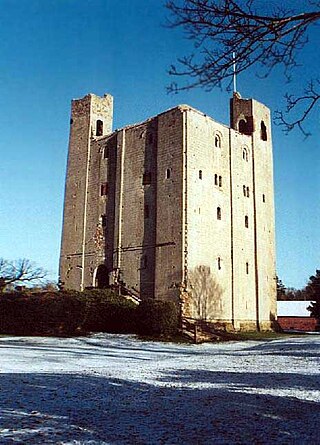
John de Vere, 7th Earl of Oxford was the nephew and heir of Robert de Vere, 6th Earl of Oxford who succeeded as Earl of Oxford in 1331, after his uncle died without issue.
Alice of Norfolk or Alice of Brotherton was an English noblewoman. She was the daughter of Thomas of Brotherton, and a granddaughter of King Edward I of England. She married Edward Montagu, 1st Baron Montagu.

The Battle of Pontvallain, part of the Hundred Years' War, took place in the Sarthe region of north-west France on 4 December 1370, when a French army under Bertrand du Guesclin heavily defeated an English force which had broken away from an army commanded by Sir Robert Knolles. The French numbered 5,200 men, and the English force was approximately the same size.
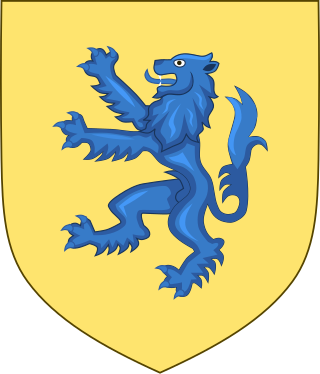
Henry Percy, 9th Baron Percy of Topcliffe, 2nd Baron Percy of Alnwick was the son of Henry de Percy, 1st Baron Percy of Alnwick, and Eleanor Fitzalan, daughter of Sir Richard FitzAlan, 8th Earl of Arundel, and sister of Edmund FitzAlan, 9th Earl of Arundel.
Sir John Minsterworth was a fourteenth-century English knight from Gloucestershire, who fought in the Hundred Years' War and was executed by King Edward III for treason. Nothing is known of his upbringing but he first comes to prominence during the 1370 invasion of France. The war, under the command of the King's son, Edward the Black Prince, was going poorly and had only recently restarted after a nine-year truce. Minsterworth was part of a force sent to relieve the English command in France under the nominal leadership of Sir Robert Knolles, whom contemporaries praised for his military acumen. Landing in the north, Knolles and Minsterworth carved their way to the west of France. There, divisions among the leaders—which may have been present before the campaign began—erupted into mutiny.
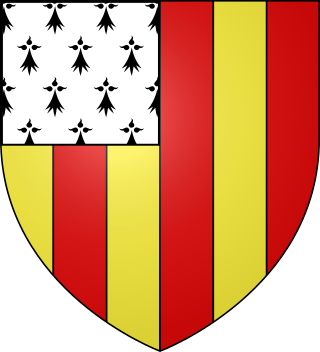
Ralph Basset, 2nd Baron Basset of Drayton was a 13th-14th century English nobleman who fought in both the Anglo-French War and in the First War of Scottish Independence.
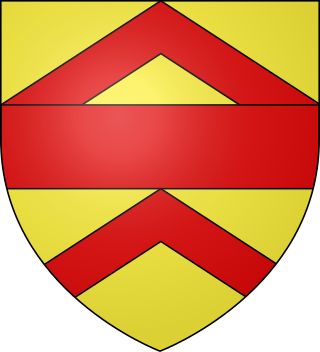
Walter FitzWalter, 3rd Baron FitzWalter was an English soldier and nobleman.
Sir Alan Buxhull K.G. was an English soldier and nobleman.

Jean IV de Mauquenchy, Lord of Blainville, also known as Mouton de Blainville, was a French soldier and nobleman. He was a Marshal of France during the Hundred Years' War.
Château de la Faigne was a castle in Pays de la Loire, France.